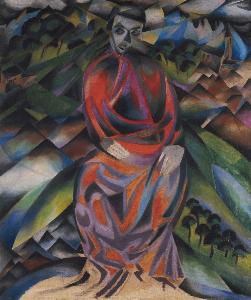Heinrich Maria Davringhausen
Heinrich Maria Davringhausen
Place: Aachen
Born: 1894
Death: 1970
Biography:
Heinrich Maria Davringhausen was a German painter associated with the New Objectivity. He was born in Aachen and mostly self-taught as a painter. He began as a sculptor, studying briefly at the Düsseldorf Academy of Arts before participating in a group exhibition at Alfred Flechtheim's gallery in 1914. He also traveled to Ascona with his friend the painter Carlo Mense that year. At this early stage his paintings were influenced by the expressionists, especially August Macke. Having lost his left eye during his adolescence, Davringhausen was exempted from military service in World War I. From 1915 to 1918, he lived in Berlin where he became part of a group of left-wing artists that included Herwarth Walden and John Heartfield. In 1919 he had a solo exhibition at Hans Goltz' Galerie Neue Kunst in Munich, and exhibited in the first 'Young Rhineland' exhibition in Düsseldorf. Davringhausen became a member of the 'Novembergruppe' and gained some prominence among the artists representing a new tendency in German art of the postwar period. In 1925 he participated in the Neue Sachlichkeit (New Objectivity) exhibition in Mannheim which brought together many leading 'post-expressionist' artists, including Grosz, Otto Dix, Max Beckmann, Alexander Kanoldt and Georg Schrimpf. Davringhausen went into exile with the fall of the Weimar republic in 1933, first going to Majorca, then to France. In Germany approximately 200 of his works were removed from public museums by the Nazis on the grounds that they were degenerate art. Prohibited from exhibiting, Davringhausen was interned in Cagnes-sur-Mer but fled to Côte D' Azur. In 1945 however he returned to Cagnes-sur-Mer, a suburb of Nice, where he remained for the rest of his life. He worked as an abstract painter under the name Henri Davring until his death in Nice in 1970.

